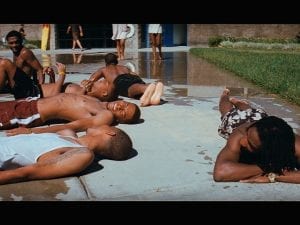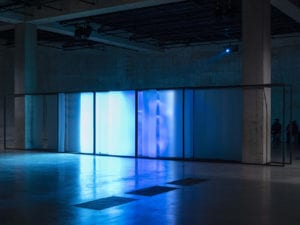Visionary creative Nam June Paik (1932-2006) pioneered media and video art with a series of seminal works in the 1960s and 1970s. Back then, he predicted that “someday artists will work with capacitors, resistors and semi-conductors as they work today with brushes, violins and junk.” Over half a century later, his words ring true as we survey the innovative work contemporary practitioners are producing. Now, Art Gallery of Ontario spotlights 11 such large-scale works in Bright Signs: Spotlight on Video Art, showcasing the myriad ways artists create powerful multisensory experiences using light, sound and moving images. On display are projects from well-known names, including Jenny Holzer, Kahlil Joseph and Sarah Sze. Curator Debbie Johnsen aptly states: “Harnessing state-of-the-art technology, video art has the capacity to make moments in time – be they real or imaginary, past or present – feel startlingly immediate. In doing so, these artworks raise powerful questions about memory, history and visibility.”
Bright Signs is anchored by two immersive environments, one of which comes from American artist Theaster Gates (b. 1973). In the centre of the room, an iceberg-shaped disco ball – called Houseberg – scatters light in all directions. Around the space, we find the ghostly frame of an empty DJ booth as well as film showing people dancing projected onto the walls. The piece is called Progress Palace and the multi-sensory installation references the influential 1970s Chicago nightclub scene as well as “the Godfather of House” DJ Frankie Knuckles. Gates’ practice revolves around celebrating and preserving significant people and places such as these. He sees nightclubs as historical sanctuaries for queer and Black people. As such, this monumental installation is also an invitation for visitors to find liberation through music.
Elsewhere, Kahlil Joseph (b. 1981) presents Wildcat (Aunt Janet) (2016). Filmed on location in the sparsely populated Oklahoma town of Grayson (formerly called Wildcat), the film recounts the origins of one of the last surviving African American rodeos in the USA’s mid-west. On screen, ethereal black and white videos of bull riders and cowgirls highlights this thriving community. The project is named after the late Aunt Janet, a member of the family who founded the event. In Wildcat, Joseph represents her as a young girl to honour her memory. Reflecting on the work, Joseph states: “Black people are light years more advanced than the circulating ideas and images would have you believe. So, an all-black town with an all-black rodeo in the American heartland was a kind of vortex or portal through which I could actually show this.”
Both projects use technology to preserve and uplift marginalised voices. Their pieces immerse the viewer in community spaces – past and present – that we don’t often get to see on screen. Gates welcomes us into a place where people are free to express themselves whilst Joseph challenges the popular perception of cowboys by shining a light on the African Americans who are also part of the picture. In this way, Bright Signs brings together artwork from practitioners who are using the medium to share important stories and create immersive experiences – that will stay with audiences long after they have left the gallery.
Art Gallery of Ontario, Bright Signs: Spotlight on Video Art | Until 14 October
Words: Diana Bestwish Tetteh
Image Credits:
- Theaster Gates. Baby Neon, 2016. Bent glass neon tubing, electrical transformer, 91.4 x 45.7cm. Art Gallery of Ontario. Purchased with funds from the Modern and Contemporary Curatorial Committee, the Michael and Diana Hasley Fund, the Molly Gilmour Fund, the Janet and Michael Scott Fund, the David Yuile and Mary Elizabeth Hodgson Fund, the Ivey Foundation Contemporary Art. © Theaster Gates. 2017/32.





